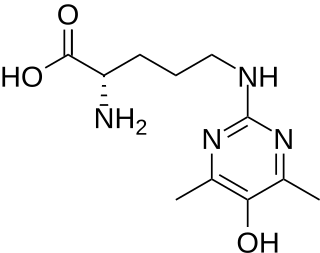
Taurine, or 2-aminoethanesulfonic acid, is an organic compound that is widely distributed in animal tissues. It is a major constituent of bile and can be found in the large intestine, and accounts for up to 0.1% of total human body weight. It is named after Latin taurus meaning bull or ox, as it was first isolated from ox bile in 1827 by German scientists Friedrich Tiedemann and Leopold Gmelin. It was discovered in human bile in 1846 by Edmund Ronalds.
Glycosylation is the reaction in which a carbohydrate, i.e. a glycosyl donor, is attached to a hydroxyl or other functional group of another molecule in order to form a glycoconjugate. In biology, glycosylation usually refers to an enzyme-catalysed reaction, whereas glycation may refer to a non-enzymatic reaction. Glycosylation is a form of co-translational and post-translational modification. Glycans serve a variety of structural and functional roles in membrane and secreted proteins. The majority of proteins synthesized in the rough endoplasmic reticulum undergo glycosylation. Glycosylation is also present in the cytoplasm and nucleus as the O-GlcNAc modification. Aglycosylation is a feature of engineered antibodies to bypass glycosylation. Five classes of glycans are produced:
Glycation is the covalent attachment of a sugar to a protein or lipid. Typical sugars that participate in glycation are glucose, fructose, and their derivatives. Glycation is the non-enzymatic process responsible for many complications in diabetes mellitus and is implicated in some diseases and in aging. Glycation end products are believed to play a causative role in the vascular complications of diabetes mellitus.

D-Erythrulose (also known as erythrulose) is a tetrose carbohydrate with the chemical formula C4H8O4. It has one ketone group and so is part of the ketose family. It is used in some self-tanning cosmetics, in general, combined with dihydroxyacetone (DHA).
Advanced glycation end products (AGEs) are proteins or lipids that become glycated as a result of exposure to sugars. They are a bio-marker implicated in aging and the development, or worsening, of many degenerative diseases, such as diabetes, atherosclerosis, chronic kidney disease, and Alzheimer's disease.

Sevelamer (rINN) is a phosphate binding medication used to treat hyperphosphatemia in patients with chronic kidney disease. When taken with meals, it binds to dietary phosphate and prevents its absorption. Sevelamer was invented and developed by GelTex Pharmaceuticals. Sevelamer is marketed by Sanofi under the brand names Renagel and Renvela.

Methylglyoxal (MGO) is the organic compound with the formula CH3C(O)CHO. It is a reduced derivative of pyruvic acid. It is a reactive compound that is implicated in the biology of diabetes. Methylglyoxal is produced industrially by degradation of carbohydrates using overexpressed methylglyoxal synthase.

Alagebrium was a drug candidate developed by Alteon, Inc. It was the first drug candidate to be clinically tested for the purpose of breaking the crosslinks caused by advanced glycation endproducts (AGEs), thereby reversing one of the main mechanisms of aging. Through this effect Alagebrium is designed to reverse the stiffening of blood vessel walls that contributes to hypertension and cardiovascular disease, as well as many other forms of degradation associated with protein crosslinking. Alagebrium has proven effective in reducing systolic blood pressure and providing therapeutic benefit for patients with diastolic heart failure.

Human serum albumin is the serum albumin found in human blood. It is the most abundant protein in human blood plasma; it constitutes about half of serum protein. It is produced in the liver. It is soluble in water, and it is monomeric.

RAGE, also called AGER, is a 35 kilodalton transmembrane receptor of the immunoglobulin super family which was first characterized in 1992 by Neeper et al. Its name comes from its ability to bind advanced glycation endproducts (AGE), which include chiefly glycoproteins, the glycans of which have been modified non-enzymatically through the Maillard reaction. In view of its inflammatory function in innate immunity and its ability to detect a class of ligands through a common structural motif, RAGE is often referred to as a pattern recognition receptor. RAGE also has at least one other agonistic ligand: high mobility group protein B1 (HMGB1). HMGB1 is an intracellular DNA-binding protein important in chromatin remodeling which can be released by necrotic cells passively, and by active secretion from macrophages, natural killer cells, and dendritic cells.

Glucosepane is a lysine-arginine protein cross-linking product and advanced glycation end product (AGE) derived from D-glucose. It is an irreversible, covalent cross-link product that has been found to make intermolecular and intramolecular cross-links in the collagen of the extracellular matrix (ECM) and crystallin of the eyes. Covalent protein cross-links irreversibly link proteins together in the ECM of tissues. Glucosepane is present in human tissues at levels 10 to 1000 times higher than any other cross-linking AGE, and is currently considered to be the most important cross-linking AGE.
The Amadori rearrangement is an organic reaction describing the acid or base catalyzed isomerization or rearrangement reaction of the N-glycoside of an aldose or the glycosylamine to the corresponding 1-amino-1-deoxy-ketose. The reaction is important in carbohydrate chemistry, specifically the glycation of hemoglobin.

N(6)-Carboxymethyllysine (CML), also known as N(epsilon)-(carboxymethyl)lysine, is an advanced glycation endproduct (AGE). CML has been the most used marker for AGEs in food analysis.

Pentosidine is a biomarker for advanced glycation endproducts, or AGEs. It is a well characterized and easily detected member of this large class of compounds.

Amine oxidase, copper containing 3 (AOC3), also known as vascular adhesion protein (VAP-1) and HPAO is an enzyme that in humans is encoded by the AOC3 gene on chromosome 17. This protein is a member of the semicarbazide-sensitive amine oxidase family of enzymes and is associated with many vascular diseases.

Dolichyl-diphosphooligosaccharide—protein glycosyltransferase 48 kDa subunit is an enzyme that in humans is encoded by the DDOST gene.
Amyloidosis is the accumulation on misfolded protein fibers in the body. This is very common condition associated with many of the chronic illness. Haemodialysis-associated amyloidosis is a form of systemic amyloidosis associated with chronic kidney failure. Even if this is common in CKD patients with chronic regular dialysis, it can be also seen in patient with CKD but have never dialysed too.

Enzo Emanuele is an Italian clinical pathologist known for his interdisciplinary research in the field of biological psychology. He has studied the biochemical basis of romantic interpersonal attraction and identified the neurotrophin nerve growth factor (NGF) as a key biochemical mediator of falling in love. The implications of this research have been criticized in the popular press. In 2008, his genetic research, which showed an association between serotonin and dopamine receptor gene polymorphisms and certain love traits, was awarded with the International Zdenek Klein Award for Human Ethology from the Charles University in Prague, Czech Republic.

3-Deoxyglucosone (3DG) is a sugar that is notable because it is a marker for diabetes. 3DG reacts with protein to form advanced glycation end-products (AGEs), which contribute to diseases such as the vascular complications of diabetes, atherosclerosis, hypertension, Alzheimer's disease, inflammation, and aging.

Argpyrimidine is an organic compound with the chemical formula C11H18N4O3. It is an advanced glycation end-product formed from arginine and methylglyoxal through the Maillard reaction. Argpyrimidine has been studied for its food chemistry purposes and its potential involvement in aging diseases and Diabetes Mellius.















